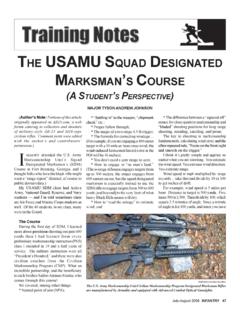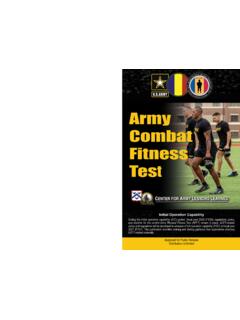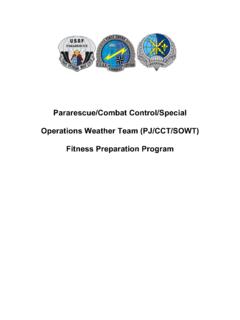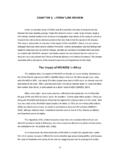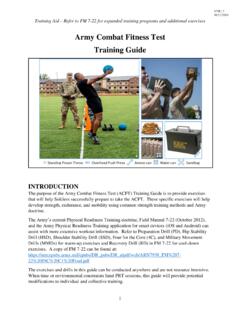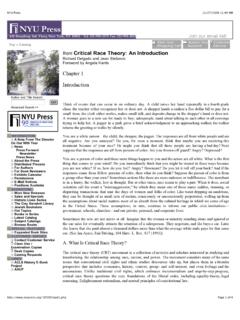Transcription of CHAPTER 7 ADVANCED RIFLE MARKSMANSHIP (Phase IV of …
1 CHAPTER 7 ADVANCED RIFLE MARKSMANSHIP (Phase IV of Basic RIFLE MARKSMANSHIP ) The procedures and techniques for implementing the Army RIFLE MARKSMANSHIP training program are based on all soldiers understanding common firing principles, being proficient marksmen, and being confident in applying their firing skills in combat . During preliminary MARKSMANSHIP instruction, instructors-trainers emphasize initial learning by reviewing, reinforcing, and practicing the basics. This CHAPTER concentrates on ADVANCED techniques and procedures the soldier will need to participate in collective training during unit live-fire training exercises. Areas discussed in this CHAPTER include ADVANCED firing positions, combat firing techniques, NBC firing, unassisted night fire, moving target engagement, short-range MARKSMANSHIP (SRM) training, and squad designated marksman (SDM) training.
2 NOTE: The unit METL and STRAC allocation will determine which ARM tasks will be trained. Section I. ADVANCED FIRING POSITIONS After mastering the four MARKSMANSHIP fundamentals in the two basic firing positions, the next step is to master the four fundamentals while firing from a variety of ADVANCED firing positions. The following paragraphs demonstrate the most common firing positions a soldier may be required to fire from. The firer's position may change but the application of the remaining three fundamentals applied from a stable position never changes. Ultimately, any firing position that aids the firer in applying the fundamentals is acceptable, as long as it is applied consistently each time it is used to avoid changing the firer's sight picture. 7-1. ALTERNATE PRONE FIRING POSITION This position is an alternative to both prone supported and unsupported firing positions (Figure 7-1).
3 The firer can assume a comfortable position while maintaining the same relationship between his body and the axis of the RIFLE . This position relaxes the stomach muscles and allows the firer to breathe naturally. Figure 7-1. Alternate prone firing position. 7-2. KNEELING SUPPORTED FIRING POSITION This position allows the soldier to obtain the height necessary to observe many target areas, taking advantage of available cover (Figure 7-2). Solid cover that can support any part of the body or RIFLE assists in firing accuracy. Figure 7-2. Kneeling supported firing position. 7-3. KNEELING UNSUPPORTED FIRING POSITION This position is assumed quickly, places the soldier high enough to see over small brush, and provides a stable firing position (Figure 7-3). The nonfiring elbow should be pushed forward of the knee so the upper arm is resting on a flat portion of the knee to provide stability.
4 The trailing foot should be placed in a comfortable position. Figure 7-3. Kneeling unsupported firing position. 7-4. STANDING FIRING POSITION To assume the standing firing position, the soldier faces his target, executes a facing movement to his firing side, and spreads his feet a comfortable distance apart (Figure 7-4). With his firing hand on the pistol grip and his nonfiring hand on either the upper handguard or the bottom of the magazine, the soldier places the butt of the RIFLE in the pocket formed by his firing shoulder so the sights are level with his eyes. The weight of the RIFLE is supported by the firing shoulder pocket and nonfiring hand. The soldier shifts his feet until he is aiming naturally at the target and his weight is evenly distributed on both feet. The standing position provides the least stability but could be needed for observing the target area since it can be assumed quickly while moving.
5 Support for any portion of the body or RIFLE improves stability. More stability can be obtained by adjusting the ammunition pouch to support the nonfiring elbow, allowing the RIFLE magazine to rest in the nonfiring hand. Figure 7-4. Standing firing position. 7-5. MODIFIED SUPPORTED FIRING POSITION Once the basic firing skills have been mastered during initial training, the soldier should be encouraged to modify positions, to take advantage of available cover, to use anything that helps to steady the RIFLE , or to make any change that allows him to hit more combat targets. The modified prone firing position uses sandbags to support the handguard and frees the nonfiring hand to be used on any part of the RIFLE to hold it steady (Figure 7-5). Figure 7-5. Modified supported firing position. 7-6. URBAN OPERATIONS FIRING POSITIONS Although the same principles of RIFLE MARKSMANSHIP apply, the selection and use of firing positions during urban operations (UO) requires some special considerations.
6 Firing from around corners could require the soldier to fire from the opposite shoulder to avoid exposing himself to enemy fire. a. The requirement for long-range observation can dictate that positions be occupied that are high above ground. Figure 7-6 shows a soldier firing over rooftops, exposing only the parts of his body necessary to engage a target. b. Figure 7-7 shows a soldier firing around obstacles. Figure 7-8 highlights the requirements for cover and RIFLE support and the need to stay in the shadows when firing from windows while making sure the muzzle of the RIFLE does not protrude out of the opening. Figure 7-6. Firing over rooftops. Figure 7-7. Firing around obstacles. Figure 7-8. Firing from windows. c. With minor modifications, the dry-fire exercises taught during preliminary MARKSMANSHIP instruction can effectively train and evaluate a soldier's ability to apply the fundamentals while in ADVANCED firing positions.
7 Repetitive training (muscle memory) will make the soldier knowledgeable in the types of corrections needed to keep the same point of aim consistently in all of the different firing positions. This increases first time target hits and soldier survivability. 7-7. MODIFIED AUTOMATIC AND BURST FIRE POSITION Maximum use of available artificial support is necessary during automatic or burst fire. The RIFLE should be gripped more firmly and pulled into the shoulder more securely than when firing in the semiautomatic mode. This support and increased grip help offset the progressive displacement of weapon-target alignment caused by recoil. To provide maximum stability, prone and supported positions are best when firing the M16-/M4-series weapon in the automatic or burst fire mode. (If the weapon is equipped with the RAS, the use of the vertical pistol grip can further increase the control the soldier has over the weapon.)
8 Figure 7-9 demonstrates three variations that can be used when firing in automatic or burst fire. The first modification shown involves forming a 5-inch loop with the sling at the upper sling swivel, grasping this loop with the nonfiring hand, and pulling down and to the rear while firing. The second modification involves grasping the small of the stock with the nonfiring hand and applying pressure down and to the rear while firing. The third modification shown is the modified machinegun position when a bipod is not available. Sandbags may be used to support the RIFLE . The nonfiring hand may be positioned on the RIFLE wherever it provides the most stability and flexibility. The goal is to maintain weapon stability and minimize recoil. Figure 7-9. Modified automatic and burst fire positions. Section II. combat FIRE TECHNIQUES The test of a soldier's training is applying the fundamentals of MARKSMANSHIP and firing skills in combat .
9 The MARKSMANSHIP skills mastered during training, practice, and record fire exercises must be applied to many combat situations (attack, assault, ambush, UO). Although these situations present problems, only two modifications of the basic techniques and fundamentals are necessary: changes to the rate of fire and alterations in weapon-target alignment. The necessary changes are significant and must be thoroughly taught and practiced before discussing live-fire exercises. 7-8. RAPID SEMIAUTOMATIC FIRE The most important firing technique during modern, fast moving combat is rapid semiautomatic fire. Rapid-fire techniques are the key to hitting the short exposure, multiple, or moving targets described previously. If properly applied, rapid semiautomatic fire delivers a large volume of effective fire into a target area. The soldier intentionally fires a quick series of shots into the target area to assure a high probability of a hit.
10 (Figure 7-10 shows the current training program for rapid semiautomatic fire.) Figure 7-10. Rapid semiautomatic fire training program. a. Effectiveness of Rapid Fire. When a soldier uses rapid semiautomatic fire properly, he sacrifices some accuracy to deliver a greater volume of effective fire to hit more targets. It is surprising how devastatingly accurate rapid fire can be. At ranges beyond 25 meters, rapid semiautomatic fire is superior to automatic fire in all measures (shots per target, trigger pulls per hit, and even time to hit). The decrease in accuracy when firing faster is reduced with proper training and repeated practice. b. Control of Rapid Semiautomatic Fire. With proper training, the soldier can properly select the appropriate mode of fire; semiautomatic fire, rapid semiautomatic fire, or automatic/burst. Leaders must assure proper fire discipline at all times.


